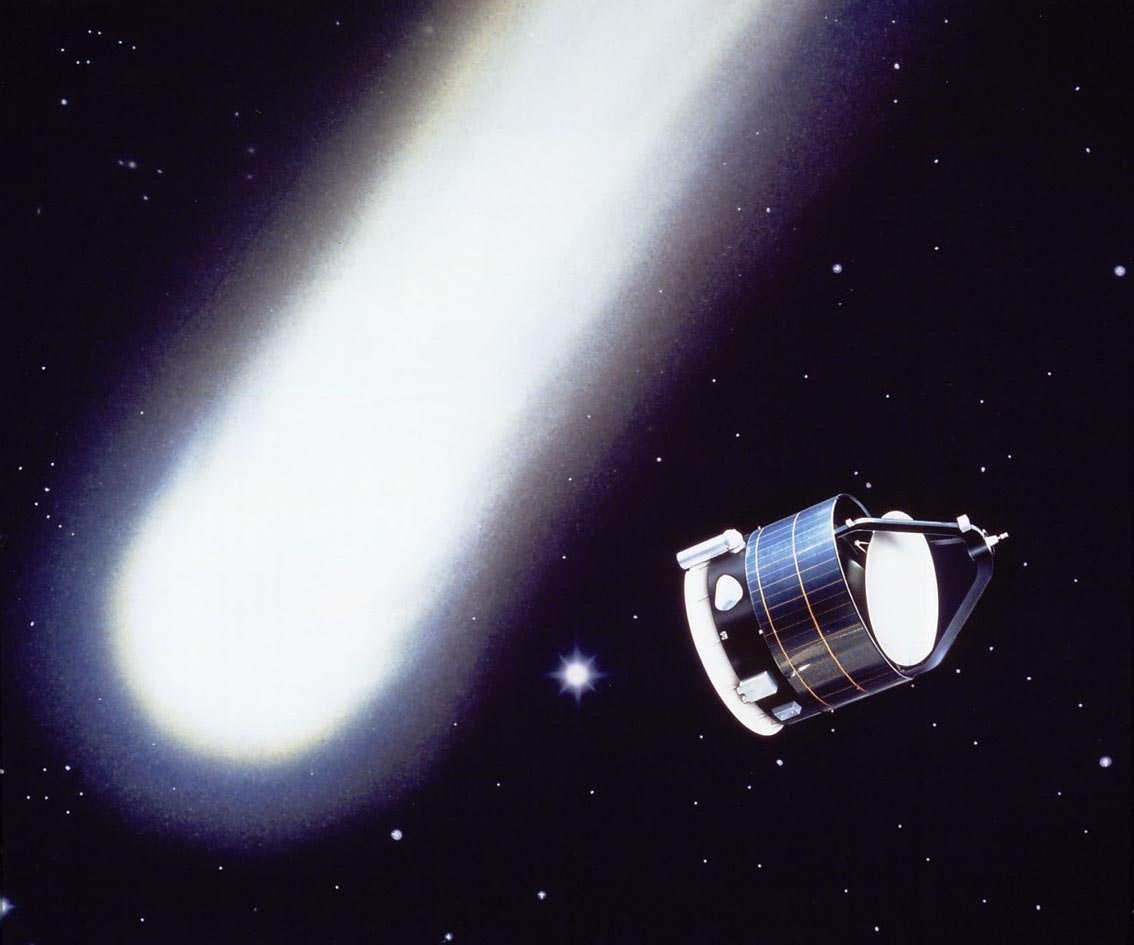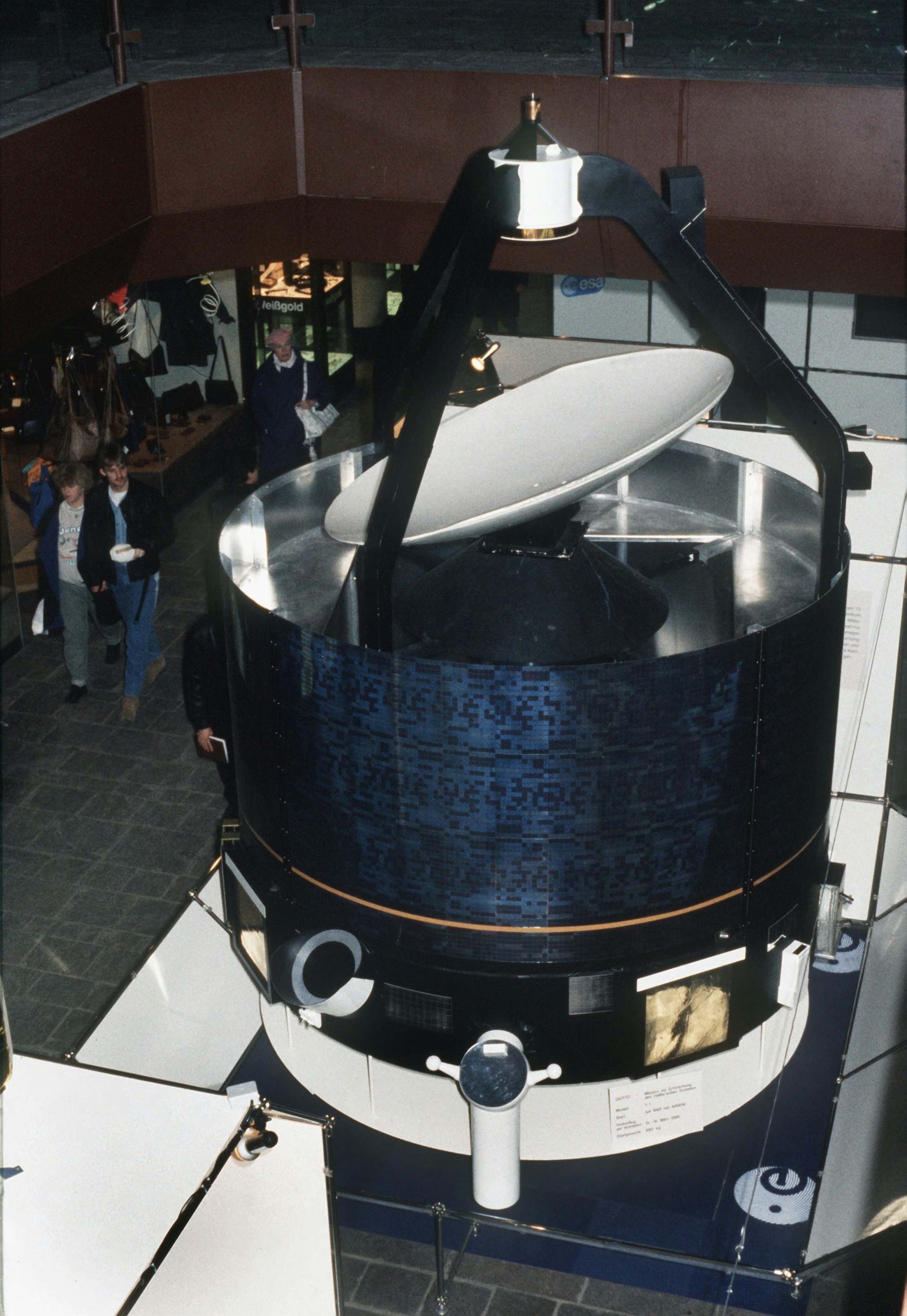
Twenty years ago this week, a small spacecraft that had already taken a beating from zipping head-on in the direction of Halley’s Comet at a speed of 245,000 kilometers per hour visited a second comet — and became the first spacecraft to do so. And this time, it was the closest a spacecraft had ever been to the nucleus.
The name of that spacecraft can be traced back to Padua, Italy, where you’ll find the Arena Chapel, famous for its deep blue frescoes of the sky across the ceiling and depictions of the Life of Christ and the Virgin painted by the Renaissance artist Giotto di Bondone. Emblazoned across the night sky, Giotto depicted the Star of Bethlehem, which was actually an illustration of Halley’s Comet. di Bondone witnessed the comet soar across the sky in 1301. Giotto and his partially celestial-inspired painting would later become the namesake for the European Space Agency’s first deep-space mission. Its destination: Halley’s Comet.
On July 2, 1985, the European Space Agency (ESA) launched Giotto, a cylindrical one-meter-wide by two-meter-tall robotic ship carrying 10 scientific instruments, from Kourou, French Guiana, into deep space to image and take near-field measurements of Halley’s Comet.

Halley’s comet exploration
Halley’s Comet is a periodic comet that orbits the Sun. Giotto was initially one spacecraft in part of a collaborative effort to study the comet that included additional five ships: NASA’s ISEE-3 craft, two from the USSR (Vega 1 and 2), and two from Japan (Sagigake and Suisei). Giotto, though, was on the front lines. Of the spacecraft in the so-called Halley’s Armada, Giotto came closest to the comet, and ESA hadn’t expected it to survive the encounter because of its proximity to the comet’s dust.
On March 14, 1986, Giotto passed by Halley’s Comet from a distance of 596 km. Halley’s Comet has a diameter of 11 km, so at first glance, Giotto’s “close” encounter might seem unremarkable. A comet’s tail, though, is another beast altogether and changes things nontrivially. As measured in violet from the spectral emission of CO2 ions, the tail of Halley’s Comet has been as long as 50 million kilometers. Comet tails and comas are by nature unpredictable and problematic for spacecraft.
Comets — sometimes called “dirty snowballs” — often have atypical elliptical orbits because they can swing from our Solar System's farthest reaches to the Sun. As the comet, made up of ice, dirt, and volatile materials, approaches the Sun, solar radiation vaporizes the volatile materials from the comet, forcing dust particles to move along with them. Streams form of gas and dust. Together, the dust and gas create an atmosphere around the comet, a coma. Solar wind and radiation exert force on the coma, forcing it away from the Sun, forming a tail.
Given the scale of a comet’s tail, and more specifically Halley’s tail, it was no small feat that Giotto was the spacecraft that came closest to the comet, successfully becoming the first spacecraft to photograph the nucleus of a comet. It produced about 2000 photographs.
The photograph depicted a nearly black oblong nucleus with three jets of volatile materials. The black color suggested that Halley’s Comet was composed of more dust than ice. The volatile material was 80 percent water, 10 percent carbon monoxide, and 2.5 percent a combination of methane and ammonia.
This feat did not come without its setbacks. During its encounter with the comet, dust impacts forced Giotto off its spin axis, and damaged the dust field that protected critical instrumentation. The comet also destroyed Giotto’s camera, mercifully after the probe captured photos of Halley’s nucleus. Despite the damage, this was only part of Giotto’s mission.

Giotto's encounter with Grigg-Skjellerup
Unlike many deep-space missions, like the Pioneer and Voyager missions destined to travel eternally into interstellar space, Giotto’s story didn’t end after its rendezvous with Halley’s Comet. After Giotto’s first success, it was rerouted for an Earth flyby so that it could do something else that no agency had done before: a gravity assist from Earth that would alter the ship’s orbit, allowing it to have an encounter with a second comet, Grigg-Skjellerup.
Gravity assists are not uncommon. Even Vega 1 and Vega 2, part of Halley’s Armada, used the gravity of Venus to intersect with Halley’s Comet. The Dawn mission that is visiting Vesta and Ceres, two of the largest asteroids in the asteroid belt, used the gravity of Mars in February 2009 to arrive at Vesta in July 2011.
ESA turned off Giotto’s scientific instruments after its trajectory was adjusted on March 15, 1986, and were reawoken on July 2, 1990, as Earth slingshotted it toward Grigg-Skjellerup. Then, two years later, on July 10, 1992, Giotto was the first spaceship to make a second comet encounter.
This time, Giotto passed by Grigg-Skjellerup at a distance of only 200 km. Giotto also survived this encounter and provided significant data for researchers, making it a resounding success — it was the first “two-for-one” cometary mission.
The ship had eleven instruments packed onboard the tiny craft that would allow the robust analysis of the comet. However, only six remained after its intercept with Halley’s Comet for the relay with Grigg-Skjellerup. In a document written by several scientists involved Giotto’s second comet flyby, they stated their confidence in the remaining instruments' ability to measure electron density, interactions between ions and solar winds, dust distribution and properties, and to differentiate boundaries.
They were right. Even though the camera was broken, Giotto provided the data to show that, unlike Halley, Grigg-Skejellerup is more icy than dirty. It is also significantly less dusty, and was expected to produce 1/200th the amount of dust as Halley’s Comet. This was strongly backed by the detection of a mere three particles during the entire encounter, the largest of them being 30 milligrams.
Giotto also detected the first charged particles from the comet’s volatiles 12 hours before encountering the comet at 440,000 km away, meaning the tail was at least that long at the time. Some of the other findings included anomalous 70-second period magnetic waves that were thought to be caused by the breaking up of water molecules around the comet by the surrounding magnetic field generated by solar winds.

Other comet missions in the wake of Giotto
Giotto is one of many cometary spacecraft. Since Giotto, cometary exploration has risen to new heights. In January 2004, after a distant flyby of asteroid 5535 Annefrank, a US spacecraft named Stardust flew within 237 km of Comet Wild 2, collecting dust from the comet before landing in the desert of Utah.
On July 3, 2005, another US spacecraft, Deep Impact, collided with Comet Tempel 1 at a speed of 23,0000 miles per hour — on purpose. NASA intended for the mission to gather information about what is beneath the comet’s surface, so the high-speed crash was necessary. The impact caused a big flash and a lot of material to be ejected. When NASA analyzed the data gathered, it detected the presence of organic material that suggest that early Earth may have been bombarded with comets that included this kind of material.
More recently, in March 2004, the ESA launched Rosetta to intercept Comet 67P/Churyumov-Gerasimenko. In 2014, its lander, Philae, touched down on the Comet after Rosetta orbited the comet at surprisingly close distances (10-30 km).
What comes next in terms of exploring comets remains as mysterious as the dirty snowballs themselves, but Giotto provided a great example for its successors, even for other missions with multiple destinations like Dawn. With its instruments turned off, Giotto passed by Earth again in 1999. Inevitably, and like the periodic comets it chased, we can expect that Giotto will quietly pass by Earth again in the future.







